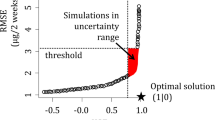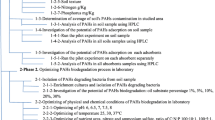Abstract
A mathematical model for the degradation of n-tridecane in a leached chernozem with different water contents was developed on the basis of budget ratios and the Mono kinetic equations. In the course of the verification, the model equations were simplified and solved numerically. The cases of uniform and step-wise initial pollutant distributions in a soil-filled co lumn were considered. The model was refined in accordance with the experimental data on the decrease in the tridecane concentration during three months. A statistically significant positive effect of the moisture and the uncontaminated upper soil layer on the rate of the tridecane decrease was shown. It was found that the degradation of the tridecane stopped and then recommenced again. The tridecane concentration in the soil at which its decrease almost stopped was determined. It was supposed that the hydrocarbon-oxidizing microorganisms, in the course of their life activity, excrete products that are accumulated and inhibit the degradation of the hydrocarbon. The parameters of the microbial activity in the soil were determined in a numerical experiment.
Similar content being viewed by others
References
V. I. Bilai and E. Z. Koval’, The Growth of Fungi on Oil Hydrocarbons (Naukova dumka, Kiev, 1980) [in Russian].
D. G. Zvyagintsev, Soil and Microorganisms (Izd. Mosk. Gos. Univ., Moscow, 1987) [in Russian].
F. A. Kamenshchikov and E. I. Bogomol’nyi, Oil Sorbents (NITs Regulyarnaya i Khaotichesk. Dinamika, Izhevsk, 2005) [in Russian].
N. A. Kireeva, V. V. Vbdop’yanov, and A. M. Miftakhova, Biological Activity of Oil-Contaminated Soils (Gilem, Ufa, 2001) [in Russian].
G. Korn and T. Korn, Reference Book on Mathematics (Nauka, Moscow, 1973) [in Russian].
A. V. Kosterin, K. A. Potashev, Z. V. Kharlamova, and I. P. Breus, “Mathematical Simulation of Nonaqueous-Phase Organic Liquid Infiltration in Soils,” Pochvovedenie, No. 7, 828–836 (2004) [Eur. Soil Sci. 37 (7), 718–725(2004)].
A. V. Kosterin and O. A. Sofinskaya, “The Effect of Water Content in the Upper Layer of Nonpolluted Soil on the Biodegradation of Tridecane,” Vestn. Samarskogo Gos. Univ., No. 2, 158–175 (2004).
V. A. Mironenko, Groundwater Dynamics (Nedra, Moscow, 1983) [in Russian].
A. I. Osipov, L. V. Ponomareva, and T. A. Ivanova, “Biological Purification of Oil-Polluted Soils,” Dokl. Ross. Akad. S.-kh. Nauk, No. 6, 20–22 (1998).
G. Yu. Riznichenko and A. B. Rubin, Biophysical Dynamics of Productive Processes (NITs Regulyarnaya i Khaotichesk. Dinamika, Izhevsk, 2004).
E. V. Smirnova, Extended Abstract of Candidate’s Dissertation in Biology (Kazan, 2003).
R. A. Suleimanov, S. M. Safonnikova, M. P. Yakhina, and S. A. Magzhanova, “Impact of Petrochemical and Oil-Processing Plants on the Sanitary State of the Soil Cover,” Gig. Sanit., No. 3, 12–15 (1996).
E. V. Shein, A Course of Soil Physics (Izd. Mosk. Gos. Univ., Moscow, 2005) [in Russian].
L. C. Yang, Lectures on the Calculus of Variations and Optimal Control Theory (Saunders, Philadelphia, 1969).
T. Gunter, U. Dornberger, and W. Fritsche, “Effects of Ryegrass on Biodegradation of Hydrocarbons in Soil,” Chemosphere 33 (2), 203–215 (1996).
ISO 11269 PT*L93-4851903 0547792 283 Soil Quality (1998).
E. M. Murphy, T. R. Ginn, A. Chilakapati, et al., “The Influence of Physical Heterogeneity on Microbial Degradation and Distribution in Porous Media,” Water Res. Res. 33 (5), 1087–1103 (1997).
S. Oya and A. J. Valocchi, “Characterization of Traveling Waves and Analytical Estimation of Pollutant Removal in One-Dimensional Subsurface Bioremedia-tion Modeling,” Water Res. Res. 33 (5), 1117–1127 (1997).
M. S. Phanikumar and D. W. Hyndman, “Interactions Between Sorption and Biodegradation: Exploring Bioavailability and Pulsed Nutrient Injection Efficiency,” Water Res. Res. 39 (5), 1–13 (2003).
W. T. Stringfellow and L. Alvarez-Cohen, “Evaluating the Relationship Between the Sorption of PAHs to Bacterial Biomass and Biodegradation,” Water Res. Res. 33, 2535–2544 (1999).
Author information
Authors and Affiliations
Additional information
Original Russian Text © A.V. Kosterin, O.A. Sofinskaya, 2010, published in Pochvovedenie, 2010, No. 6, pp. 759–766.
Rights and permissions
About this article
Cite this article
Kosterin, A.V., Sofinskaya, O.A. Simulation of tridecane degradation under different soil water contents. Eurasian Soil Sc. 43, 712–718 (2010). https://doi.org/10.1134/S1064229310060128
Received:
Accepted:
Published:
Issue Date:
DOI: https://doi.org/10.1134/S1064229310060128




